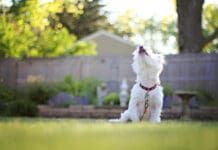Excerpted from Keeping Your Dog’s Teeth and Gums Healthy by Dr. Randy Kidd, Lisa Rodier, CNWI, Nancy Kerns, and Lorie Long
Start by figuring out what position will be most comfortable for both you and your dog. For Angela Mees, DVM, of the Atlanta Veterinary Dental Services and her Greyhound, that’s standing. This lets Dr. Mees reach around from behind the dog, and works well for them. Smaller dogs might be happy to sit in your lap. For Atle, I’ve found that having him lie on his side works best.
Where to start? Dr. Mees advises that one approach is to divide the dog’s mouth into four quadrants, tackling one at a time. She begins with her dog’s front teeth because they’re easiest to reach. Wherever you choose to begin, start with a wet brush, and gently work each area as follows, with pressure light enough that the bristles barely bend:
- To brush the front teeth, gently pull back the dog’s lips.
- For the upper back teeth, put the brush in the dog’s cheek, and, gently holding her muzzle, close her mouth and brush. Closing the mouth controls the dog’s tongue, reducing any struggle with brushing.
- For the lower back teeth, release your hold on the muzzle a bit, slightly open the dog’s mouth, and brush the bottom back teeth.
Dr. Mees admits that getting the insides of the teeth is difficult, so don’t get discouraged if you can’t (the dog’s tongue tends to keep the inner sides of the teeth clean). And don’t be concerned about brushing your dog’s tongue and roof of her mouth.
You may be asking: What direction should you brush? According to Dr. Mees, “We’re taught circular motions, but I think if you try circular motions in a moving animal, you’re going to get frustrated! So I usually recommend side to side.” In a perfect world, you’ll gradually work up to brushing each quadrant for about 30 seconds. Nonetheless, Dr. Mees acknowledges that you might not achieve that. She gets about five to ten seconds per quadrant on her own dog, so she brushes once quickly, then tries to repeat one or two more times.
Any amount of brushing is better than none; you will see better results in your dog’s oral health, even with a dog who won’t tolerate a total of more than 20 to 40 seconds, than if you never brushed. Do as much as he will handle to start, then gradually see if you can do a little more. I’m at day five with Atle, and I’ve been able to begin brushing his back upper and lower teeth. We’re still just talking a matter of seconds, and he’s not entirely thrilled, but that’s OK. I’m not in a hurry, and he’s getting lots of treats and praise for what he gives me.
After brushing, thoroughly rinse the brush and let it air dry. It’s a good idea to replace your dog’s toothbrush every three to six months, and use a separate toothbrush for each of your dogs to prevent the spread of germs.
For more information on brushing your dog’s teeth, purchase Whole Dog Journal’s ebook Keeping Your Dog’s Teeth and Gums Healthy.





